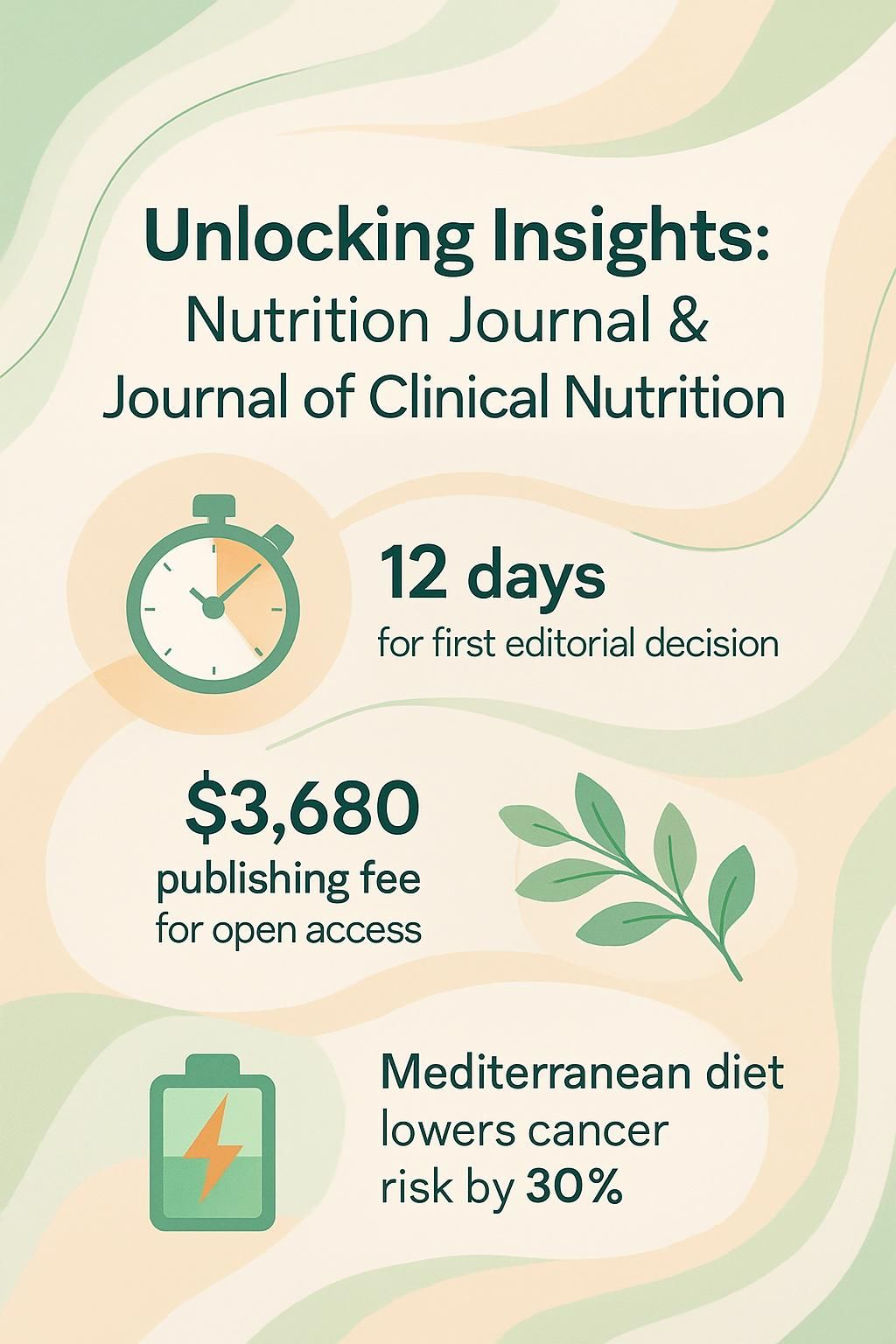Unlocking Insights: Nutrition Journal & Journal Of Clinical Nutrition
Our Nutrition Assistant AI Suite will transform your body. You will lose fat, get toned, and build muscle. Gain confidence and optimal health.
Sorting through nutrition research can feel overwhelming. You want facts you can trust and use. The Nutrition Journal offers open access to peer-reviewed studies, so you can find clear data on diet, Health, and Disease without a paywall.
This guide walks you through highlights from Nutrition Journal and the Journal of Clinical Nutrition. You will see how these journals shape clinical nutrition, public policy, and your own daily choices.
Keep reading to learn how credible research can support your well-being and decision-making.
Key Takeaways
- Nutrition Journal and Journal of Clinical Nutrition publish peer-reviewed research on Human nutrition, chronic disease prevention, and patient care. Studies include randomized controlled trials, meta-analyses, and systematic reviews.
- Nutrition Journal reports a median 12 days from submission to first editorial decision. Open access publication costs USD 3,680.
- Recent findings include diet-microbiome synergy tied to frailty, Mediterranean diet reducing cancer risk by up to 30 percent, and spirulina supplementation improving energy in multiple sclerosis.
- Evidence from these journals informs public health guidelines used by agencies such as USDA and WHO.
- Advances in nutritional Biomarker science, including large European cohort studies, help track intake of foods like whole grains and fish in clinical settings.

Overview of Nutrition Journals

Nutrition journals help move science forward on dietary patterns, Metabolism, and disease prevention. Peer review means experts check the study methods and results before publication. That gives you more reliable information for practice and daily life.
Why is nutrition research important?
Nutrition research explains how dietary intake affects health, Disease risk, and body composition. Common designs include randomized controlled trials, cohort study methods, and tools like dual-energy X-ray absorptiometry, a body scan that measures fat and lean mass. Results guide care for conditions such as Obesity, type 2 Diabetes, and Cardiovascular disease.
National datasets, including the National Health and Nutrition Examination Survey, support U.S. dietary guidelines. New technologies and Biomarkers also help clinicians track nutrient status more accurately. Clear evidence links nutrition to chronic condition management, malnutrition screening, and smart policy.
Understanding how journals evaluate evidence helps you see why some recommendations carry more weight than others.
How do peer-reviewed journals advance nutritional science?
Peer-reviewed journals use expert reviewers to assess study design, statistics, and conclusions. This process filters out weak studies and raises overall quality. Fast editorial timelines, such as the Nutrition Journal’s 12-day median to first decision, help new findings reach you sooner.
Meta-analyses and systematic reviews pool data to give stronger answers to big questions. You also see citation counts and impact factors that show how widely a paper influences the field. Reputable outlets, including the American Journal of Clinical Nutrition and Journal of Clinical Nutrition, publish trials on topics from microbiome science to dietary supplements.
Peer review builds transparency and aids safe clinical application. You get evidence that supports decisions in clinics, schools, and public health programs.
Nutrition Journal: Key Highlights
Nutrition Journal publishes studies in nutrition and Metabolism with a focus on access and speed. You can track journal insights, special issue calls, and articles in press to stay current.
What is the aim and scope of the Nutrition Journal?
The journal’s aim is to publish international peer-reviewed research that advances nutrition science and its clinical use. Typical topics include dietary intake, Epidemiology, vitamins and minerals, metabolic syndrome, and nutrition in disease prevention and care.
Papers often explore protein nutrition, precision nutrition, diet-microbiome synergy, and child eating behaviors. Large prospective cohort studies are common. The journal focuses on Human nutrition, so plant or animal studies appear only when they clearly inform human health.
The scope helps clinicians and researchers apply new methods and data to real problems, such as inflammation, gastrointestinal tract issues, or nutrient gaps.
What types of articles does the Nutrition Journal publish?
You will find original research, outcomes research, narrative and systematic reviews, and meta-analyses. Many papers address patient-centered topics, such as Diet (nutrition), Medication interactions, Vitamin B12 and Vitamin D supplementation, Infant and Milk studies, weight management, Tuberculosis nutrition support, and cancer prevention strategies using Diet.
Prospective cohort study designs and follow-up trials are common. Recent examples include liver cirrhosis management with nutrition support and postpartum dietary beliefs. Other work links eating patterns to child appetitive traits and sensory profiles.
Reviews explain mechanisms behind bioenergetics in disease and map microbiome species to frailty in older adults. If you plan to submit a Manuscript, check the call for papers and the current issue links to gauge fit.
A nurse educator shared,
A narrative review on human Milk composition made complex science simple for a parent workshop.
These formats make the journal useful for bedside decisions and policy discussions.
Which featured studies have impacted nutritional science?
Several featured studies stand out. The ROLO Longitudinal Birth Cohort Study links sensory processing to child appetitive traits, shaping pediatric counseling. Research on the Dietary Inflammatory Index shows how pro-inflammatory eating patterns relate to higher colorectal cancer risk.
Diet-microbiome synergy studies connect food choices, gut bacteria, and frailty in aging. Clinical trials on spirulina suggest modest improvements in quality of life for people with multiple sclerosis. Many articles apply text mining and include follow-up periods that strengthen conclusions.
These findings support better care across pregnancy, chronic illness, and aging, and they often carry high citation impact in Biomedical sciences.
Recent Articles in Nutrition Journal
Recent work highlights practical applications of nutrition research, including data mining and clinical outcomes. These studies help you link daily Diet to long-term health.
How does sensory processing affect child appetitive traits?
Children with oral sensory hypersensitivity are more likely to be picky eaters between ages 9 and 11. Studies of healthy mother-child pairs show strong ties between a child’s sensory profile and food acceptance.
Researchers also note parallels between maternal and child sensory traits, likely due to shared environments and mealtime routines. Social-emotional factors interact with appetite signs, which can shape growth and nutrition status. Early screening and parent coaching can reduce stress at the table and improve diet quality.
These insights point to simple actions, such as gradual exposure to textures and calm mealtime routines.
What is the link between dietary inflammatory index and colorectal cancer risk?
The Dietary Inflammatory Index, or DII, estimates how much your diet can raise or lower inflammation. Higher DII scores, often driven by processed meats, refined grains, and sugary drinks, link to a higher risk of colorectal cancer.
Large observational cohorts report that people with a low DII, often those who eat more plants, whole grains, and fish, face lower risk. Randomized controlled trials continue to test anti-inflammatory patterns to confirm cause and effect.
To lower your DII score, build meals around vegetables, beans, fruits, and whole grains. Small changes can add up over time.
How does diet-microbiome synergy influence frailty?
Your Diet shapes the gut microbiome, the community of microorganisms that help digest food and produce helpful compounds. Recent studies show that this synergy influences frailty in older adults.
High-fiber, plant-forward eating supports a healthier microbiome and reduces markers linked to frailty. Personalized nutrition uses molecular phenotyping and Metabolomics, the study of small molecules in the body, to tailor diet advice. Trials show that higher fiber intake can shift gut bacteria within weeks, with better strength and function in some participants.
In many clinics, simple steps like adding beans, oats, or fermented foods lead to noticeable gains in energy within months.
Can spirulina supplementation improve quality of life in multiple sclerosis patients?
Randomized controlled trials in Nutrition Journal report that spirulina supplementation can modestly improve energy and reduce fatigue scores for people with multiple sclerosis. Researchers used validated quality-of-life tools to track change over time.
If you consider spirulina, discuss it with your healthcare provider first. Supplements can interact with Medication or not fit your condition. Evidence suggests spirulina may support daily function, but it should sit alongside prescribed therapies.
This is general information, not medical advice. Seek care from a qualified clinician for personal guidance.
Journal of Clinical Nutrition: Key Features
The Journal of Clinical Nutrition focuses on how nutrition research applies in medical settings. Articles help translate lab findings into actions that improve patient outcomes.
What are the aims and scope of the Journal of Clinical Nutrition?
This journal covers basic and applied nutritional sciences with a strong clinical focus. Manuscripts often explore prevention, management, and therapy across conditions. Methods include trials, outcomes research, feasibility studies, and animal research when it informs human care.
Topics range from cancer prevention and plant-based diets to ICU nutrition protocols. With strong citation impact, the journal influences clinical nutritionists and researchers worldwide.
The scope supports day-to-day practice by turning evidence into clear, testable strategies.
How does the journal focus on clinical applications of nutrition research?
Articles aim at direct patient benefit. Examples include nutrition interventions for pediatric cystic fibrosis, links between maternal size measures and child neurocognition, and individualized ICU feeding plans.
Findings support evidence-based care for both acute and long-term conditions. Research on supplements like spirulina helps teams decide when, how, and for whom a product may help. Each report works to connect study results with bedside decisions and public health guidance.
Clinicians can use these insights to update protocols and counseling tools.
Recent Articles in Journal of Clinical Nutrition
Recent studies address cancer prevention, dietary patterns, and patient outcomes. Strong citations show how these papers guide practice and policy.
How does nutrition contribute to cancer prevention?
Eating more fruits, vegetables, and whole grains supports your body’s defense systems. Large European cohort studies, such as the European Prospective Investigation into Cancer and Nutrition, link plant-forward diets to lower cancer risk.
Patterns like the Mediterranean diet, which emphasizes olive oil, fish, legumes, nuts, and produce, associate with less colorectal cancer. Research also examines inflammation from certain foods and its role in cancer development.
Practical steps include limiting processed meats and sugary drinks. Choose fiber-rich meals that supply antioxidants for cell protection. Ask your clinician for advice tailored to your history.
What are the health benefits of the Mediterranean diet?
The Mediterranean diet supports heart health and lowers chronic disease risk. Studies report up to a 30 percent reduction in major cardiovascular events for people who follow it well.
Benefits often include better blood pressure control, healthier cholesterol levels, and easier weight management. Many people also report steadier energy and improved mood as eating patterns stabilize.
Build your plate with vegetables, whole grains, legumes, fruits, nuts, and olive oil. Add fish a few times a week, and keep red meat and sweets as occasional items.
How is nutrition managed in ICU settings?
ICU nutrition uses individualized plans. Teams choose enteral feeding, through the gut, or parenteral feeding, through the vein, based on patient status. A special collection in Nutrition Journal reviewed ICU nutrition strategies, including pediatric interventions that compared structured packages with standard counseling.
Key targets include calories, protein, fluids, and micronutrients. Hospitals often follow strict protocols and adjust based on daily labs. Outcome measures include muscle mass, weight trends, and recovery markers in both adults and children.
Animal models can explain metabolic changes during illness. Clinicians then test those insights in human studies.
What are the recent advances in nutritional biomarker science?
Nutritional Biomarker science is moving fast. Research teams, including the Landberg group, have identified and validated intake biomarkers for whole grains, fish, and coffee. Metabolomics helps detect these markers in blood or urine, which improves diet assessment beyond self-reports.
Work with large European cohorts, such as Sweden’s SIMPLER project and Denmark’s Diet, Cancer and Health Next Generation, supports this progress. Biomarkers let clinicians estimate intake more precisely and link foods to disease risk and outcomes.
Better measurement leads to better guidance in clinics and public health programs.
Comparing Nutrition Journal and Journal of Clinical Nutrition
These journals complement each other. One spreads broad nutrition science, the other tightens the focus on clinical care.
What are the main differences in focus areas between the two journals?
Understanding how the journals differ helps you target the right audience and outlet for your work.
| Aspect | Nutrition Journal | Journal of Clinical Nutrition |
|---|---|---|
| Scope | Addresses basic and applied research in nutrition across populations | Focuses on clinical applications and interventions in nutrition |
| Key Focus Areas | Includes molecular nutrition, public health, diet-microbiome work, plant-based patterns, and policy | Centers on clinical nutrition practice, therapy, and disease management |
| Article Types | Publishes original research, reviews, meta-analyses, and policy papers | Accepts clinical research, systematic reviews, and practice guidelines |
| Subject Inclusion | Considers plant and animal studies when relevant to human health | Rarely includes plant or animal studies unless directly applicable |
| Open Access Policy | Strong open access model, publishing fee USD 3,680 | Primarily subscription access with some open access options |
| Audience | Researchers, policymakers, and practitioners across nutrition science | Healthcare professionals, clinical dietitians, and medical researchers |
| Recent Featured Topics | Sensory processing and child appetite, DII and cancer risk, microbiome synergy, spirulina and MS | Cancer prevention, Mediterranean diet, ICU nutrition, dietary biomarkers |
How do they each uniquely contribute to nutrition research?
Each journal fills a different need for readers and authors.
| Aspect | Nutrition Journal | Journal of Clinical Nutrition |
|---|---|---|
| Focus Area | Broad nutrition research spanning population studies, basic science, and public health | Clinical applications, patient interventions, and translational nutrition |
| Publication Speed | Median 12 days to first decision for rapid sharing | Timely access with traditional peer review timelines |
| Article Types | Original research, reviews, case reports, and commentaries | Clinical trials, cohort studies, clinical reviews, and guidelines |
| Access | Primarily open access for global readership | Often subscription-based, with free PDFs to authors and some discounts |
| Special Topics | Hosts special issues on emerging nutrition themes | Runs special editions on clinical advances and challenges |
| Impact on Research | Builds foundational knowledge that informs study design and practice | Shapes clinical guidelines and hospital protocols |
| Support for Authors | Streamlined submissions with fast editorial decisions | Author support includes free PDFs and publication discounts |
Impact of Nutrition Journals on Public Health
Strong evidence changes lives. These journals gather the data that turns into programs and policies.
How do nutrition journals help address global malnutrition?
Peer-reviewed research maps the drivers of undernutrition. Studies on maternal diets, child feeding, and local food systems reveal where gaps begin and how to close them. Global databases track trends, including beverage intake among women of childbearing age.
Field reports often show how maternal nutrition shapes child growth and learning in regions such as sub-Saharan Africa. Findings inform training, supply planning, and community programs. The work also guides donors and ministries in setting priorities.
This pipeline, from study to action, is key to reducing malnutrition at scale.
What is their role in shaping dietary guidelines and policies?
Editors and contributors often serve on national committees. They translate meta-analyses and outcomes research into simple recommendations for the public. Agencies like USDA and WHO rely on this evidence when updating dietary advice.
Clinical trials and animal studies together can explain mechanisms and suggest safe ranges for nutrients. Policymakers then decide how to reflect that in targets, labels, and education.
Clear methods and transparent data help build trust in the final guidelines.
Special Topics in Nutrition Journals
Hot topics often start in special issues, then move into practice.
What are the key insights on sports nutrition?
Recent collections highlight how timing and macronutrient balance improve performance and recovery. A mix of protein and carbohydrates soon after exercise supports faster muscle repair.
Mechanistic studies, including animal research, explore how supplements like creatine and spirulina may reduce fatigue. Results can guide training blocks and competition prep.
Use these insights to fine-tune pre- and post-workout meals and to plan recovery days.
How do plant-based diets affect health?
Trials led by the Landberg team, with more than 1,500 participants across about 15 studies, report several benefits. Plant-forward patterns can improve cholesterol, support blood sugar control, and reduce cardiometabolic risk.
Randomized controlled trials also show better satiety, the feeling of fullness, after meals centered on plants. Some studies report lower inflammation markers in people who follow a structured plan.
Practical steps include choosing beans, nuts, and whole grains as default proteins and starches, then adding vegetables and healthy oils.
What is the role of the microbiome in nutrition?
Your gut microbiome helps break down fiber and other compounds, which can produce short-chain fatty acids that protect the gut and support immunity. Patterns in gut bacteria relate to blood sugar control and cholesterol levels.
NIH-funded work led by Dr. Qi Sun supports precision nutrition. OMICs tools, which study genes and proteins, help tailor diet plans to reduce heart disease risk.
Simple actions, like eating more prebiotics from onions, garlic, and bananas, or adding yogurt and kefir, can support a healthier microbial mix.
How to Access and Utilize Nutrition Journals
You can use open access or subscription routes. Both help you keep up with evidence and apply it in your work.
What open access options are available for nutrition journals?
Nutrition Journal offers open access, which makes articles free for readers. The article processing fee is USD 3,680, excluding taxes, with possible reductions based on funding or location.
Open access speeds knowledge sharing to students, clinicians, and communities without institutional subscriptions. This model can boost citation impact and real-world use.
Authors should check the aims and scope and review recent issues to ensure a good fit before submission.
How does subscription-based access work?
With a subscription, you or your institution pays to read current and archived content. Authors may choose subscription publishing with no author fee. Subscribers get immediate access to new issues, while others might pay per article.
Universities and hospitals often maintain subscriptions, which makes it easier for teams to stay current on clinical nutrition, microbiome research, and policy work. This model funds editorial and peer review services.
Ask your library about access, interlibrary loans, or document delivery.
What tips can help researchers and practitioners use these journals effectively?
- Sign in on the Nutrition Journal home page for alerts and RSS feeds to catch articles in press and special issue calls.
- Save free PDFs provided to authors for your reference library and teaching.
- If available, use discounts on publications to expand access to related research.
- Email journalsubmissions@springernature.com with questions about policies or Manuscript preparation.
- Search with focused terms, such as
Dietary Inflammatory Index
,microbiome synergy
, orspirulina supplementation
. - Organize findings by folders, for example Mediterranean diet, ICU nutrition, and biomarkers.
- Apply insights in practice, such as using sensory processing research to guide pediatric counseling.
- Track featured studies that shift guidelines or inform public health action.
- Use author services to streamline submission and improve clarity.
- Adapt practical lessons from case reports and outcomes research to your setting.
These steps help you turn evidence into action and stay sharp in a fast-moving field.
Future Directions for Nutrition Journals
New tools and faster workflows are changing how nutrition research is done and shared.
What emerging research trends are shaping nutrition journals?
OMICs and Metabolomics are growing quickly. These methods study genes, proteins, and small molecules to show how food affects health at a biological level. Personalized nutrition uses molecular phenotyping to match diet advice to your biology.
Another trend is validating new biomarkers of intake. Reliable markers in blood or urine can replace some self-reports and improve accuracy.
These advances strengthen guidelines and help clinicians tailor care in real time.
How is technology being integrated into nutrition studies?
Digital platforms now manage submissions, peer review, and publication, often delivering first decisions in about 11 to 12 days. You can track status and respond to reviewer comments quickly.
Researchers use data mining and Machine learning to analyze electronic records, food logs, and genetics at scale. Mobile apps, wearables, and online surveys collect real-time diet data with less burden on participants.
Technology expands what studies can measure and speeds up how evidence reaches your clinic plate.
Conclusion
Nutrition Journal and the Journal of Clinical Nutrition give you trusted research on Diet, clinical nutrition, and public health. From child appetitive traits to cancer prevention and Biomarker science, these journals offer practical findings you can use.
Reading current issues, special issues, and articles in press keeps you ahead of the curve. Use this evidence to update your habits, inform your care, and support better policies. For personal medical advice, speak with your healthcare provider before changing your diet or starting supplementation.
FAQs
1. What is the main focus of Nutrition Journal and Journal of Clinical Nutrition?
Nutrition Journal and Journal of Clinical Nutrition publish peer-reviewed research on dietary science, nutrient intake, and health outcomes. These publications help readers understand how food choices affect well-being.
2. How do these journals use data to support their findings?
Both journals present evidence from clinical studies, population surveys, or laboratory tests. They often include tables that show nutrient values or statistics about diet-related diseases.
3. Who can benefit from reading these nutrition journals?
Healthcare professionals, researchers in food science, students studying human biology, and anyone interested in healthy eating habits will find valuable insights in these publications.
4. Can you share a personal example related to information found in these journals?
After reading an article about fiber-rich diets lowering cholesterol levels in adults with heart risk factors, I added more whole grains and legumes to my meals; my next checkup showed improved cholesterol numbers.
Summary:
Nutrition Journal and Journal of Clinical Nutrition provide reliable research on diet’s impact on health using clear data presentation. Their articles guide both experts and everyday readers toward better nutritional decisions based on scientific evidence.







